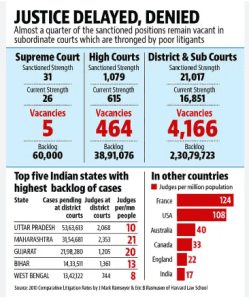THE CONTEXT: The debate over judicial appointments in India has intensified due to the challenges posed by the current Collegium system and the defunct NJAC. With significant judicial vacancies and case backlogs, there is an urgent need to reform the appointment process to ensure efficiency and transparency.

MORE ABOUT THE NJAC ISSUE:
In the Fourth Judges Case, formally known as Supreme Court Advocates-on-Record Association v. Union of India, the Supreme Court raised several critical points regarding the NJAC:
- Violation of Judicial Independence: The Court held that the NJAC compromised the independence of the judiciary, which is part of the Constitution’s basic structure. By including the Union Law Minister and two eminent persons, the NJAC was perceived as granting the executive undue influence over judicial appointments, potentially affecting judicial independence.
- Basic Structure Doctrine: In the Fourth Judges Case, the Court emphasized that any amendment affecting the Constitution’s basic structure, such as judicial independence, is unconstitutional. The judiciary must remain free from executive interference to uphold the rule of law and protect civil rights.
- Criticism of the Collegium System: While striking down the NJAC, the Court acknowledged criticisms of the Collegium system, particularly its lack of transparency and accountability. The judgment invited the government to propose improvements to the Collegium system, recognizing the need for reform in judicial appointments.
- Dissenting Opinion: Justice J. Chelameswar, the lone dissenter in the Fourth Judges Case, argued that the NJAC could have checked the Collegium system’s lack of transparency and potential nepotism. He highlighted the need for transparency in judicial appointments and suggested that the NJAC could have introduced necessary reforms.
THE ISSUES:
- Judicial Vacancies and Case Pendency: A significant number of judicial vacancies exist, with 30% of seats remaining unfilled, contributing to a backlog of 60 lakh pending cases in the High Courts.
- Collegium System vs. NJAC: The debate centers around the Collegium system, criticized for its lack of transparency and accountability, versus the NJAC, which the Supreme Court struck down for potentially undermining judicial independence by giving the government excessive control.
- Judicial Independence vs. Government Control: There is a tension between maintaining judicial independence and allowing government participation in the appointment process. The judiciary argues that the NJAC could compromise impartiality, while some legal professionals believe it could expedite appointments.
- Lessons from International Models: Judicial appointment systems in other countries, such as the UK, South Africa, and France, involve a mix of judiciary, executive, and lay members in the selection process, suggesting that India could learn from these models.
- Reworking the NJAC: The NJAC could be reformed to address its shortcomings by incorporating feedback from various stakeholders to balance judicial independence with accountability.
- Need for Efficient Judicial Appointments: A more efficient system of appointing judges is urgently needed to prevent delays in justice, a common issue in India. A balanced approach is advocated to ensure both efficiency and integrity in judicial appointments.
THE WAY FORWARD:
- Revisiting the NJAC Framework: The National Judicial Appointments Commission (NJAC) could be restructured to address its previous shortcomings while maintaining judicial independence. This could involve more precise definitions of its members’ roles and responsibilities and ensuring a balanced representation of the judiciary, executive, and civil society. The NJAC’s democratic structure might expedite judicial appointments, as seen in other countries with similar systems, like the UK’s Judicial Appointments Commission, which includes a mix of judicial and lay members.
- Increasing Judicial Strength: Addressing the high vacancy rates in Indian courts is crucial. The Law Commission of India recommended increasing the number of judges to 50 per million people, a target yet to be met. Implementing this recommendation could significantly reduce case pendency. The Supreme Court in the All-India Judges’ Association v. Union of India case also directed an increase in judge strength, emphasizing the need for more judicial manpower.
- Enhancing Transparency and Accountability: The collegium system’s lack of transparency can be mitigated by adopting a more open process for judicial appointments. This could include publishing the selection criteria and the reasons for choosing particular candidates. The Memorandum of Procedure (MoP), which aims to make the appointment process transparent, should be finalized and implemented.
- Learning from International Models: India could adopt elements from international judicial appointment systems that balance independence and accountability. For instance, South Africa’s Judicial Service Commission includes members from various sectors, providing a comprehensive approach to appointments. Similarly, France’s High Council of the Judiciary involves multiple stakeholders in the appointment process, ensuring a diverse and independent judiciary.
- Addressing Judicial Pendency through Technology and ADR: Implementing technology in courts through initiatives like the e-Courts Mission Mode Project can improve efficiency. Additionally, promoting Alternative Dispute Resolution (ADR) mechanisms can help reduce the burden on courts by resolving cases outside the traditional judicial process.
- Improving Infrastructure and Resources: Enhancing court infrastructure and increasing budgetary allocations for the judiciary can improve access to justice and reduce delays. The India Justice Report suggests that per capita spending on the judiciary is insufficient, highlighting the need for increased financial support to improve the quality of justice delivery.
THE CONCLUSION:
Reforming India’s judicial appointment process is crucial to addressing the backlog of cases and maintaining judicial independence. By learning from international models and enhancing transparency, India can develop a system that balances efficiency with accountability.
UPSC PAST YEAR QUESTIONS:
Q.1 Constitutionally guaranteed judicial independence is a prerequisite of democracy. Comment. 2023
Q.2 Critically examine the Supreme Court’s judgment on ‘National Judicial Appointments Commission Act, 2014’ with reference to the appointment of judges of higher judiciary in India. 2017
MAINS PRACTICE QUESTION:
Q.1 Critically analyze the challenges and implications of the current judicial appointment system in India, focusing on the Collegium system and the National Judicial Appointments Commission (NJAC)
SOURCE:
https://www.thehindu.com/opinion/op-ed/reforming-judicial-appointments/article68593248.ece
Spread the Word



